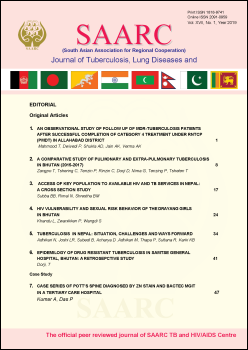Editorial Vol.17(1)
DOI:
https://doi.org/10.3126/saarctb.v17i1.25018Keywords:
TB, HIV/AIDSAbstract
On 26th September 2018, Heads of States of different countries gathered at the United Nation General Assembly for the first-ever UN High-Level Meeting (HLM) on tuberculosis (TB) to accelerate efforts in ending TB. The theme of the meeting was “United to end tuberculosis: an urgent global response to a global epidemic”. This was a landmark opportunity to marshal the political will and resources to end TB. Together we can defeat TB and overcome antimicrobial resistance by closing the funding gap for TB research and product development through equitable approaches, securing universal access to new medicines and fostering global collaboration.
TB is an infectious disease with high mortality, the most common form of antimicrobial resistance and leading cause of death in people living with HIV/AIDS. World Health Organization declared TB as global emergency. Still, TB is second leading cause of death worldwide. A good percentage of people in the developing countries continue to suffer from this menace because of poverty, gender inequality, vulnerability, discrimination and marginalization. Millions of people with TB do not have access to quality care, including affordable diagnostic test and treatment facility and is a precarious challenge to end TB globally, as well as in SAARC Region.
It is estimated that one quarter of the world’s population is infected with TB bacteria. SAARC Region has 36% of the global TB burden with 3.7 million new TB cases and 0.5 million death. Moreover these morbidity and mortality occur mainly in the economically productive age groups of 15-49 years. In order to eliminate TB from the SAARC Region before the global target, the SAARC TB and HIV/AIDS (STAC) has revised “SAARC Regional Strategy on Elimination of Tuberculosis (2018-2023)”.
This year the world TB day theme was “Its time”. So it is time to involve policy makers to advocate and take active participation in the TB control programmes. The affected and infected people with this disease can bring positive changes by combining their voices towards the elimination of the disease. Now it is time to intensify advocacy, social mobilization, partnership, research and inter-sectoral efforts to achieve the global target of ending the TB epidemic by 2030.
Chief Editor Director, STAC
Downloads
Downloads
Published
How to Cite
Issue
Section
License
Copyright © SAARC Tuberculosis and HIV/AIDS Centre (STAC), all rights reserved, no part of this publication may be reproduced, stored in a retrieval system or transmitted in any form or by any means without prior permission of the STAC.





